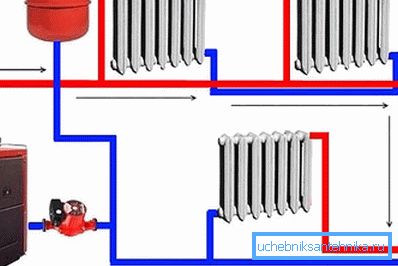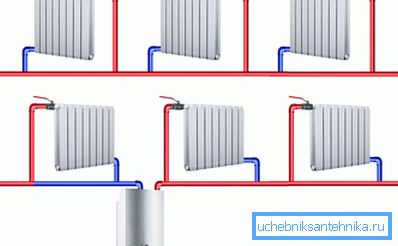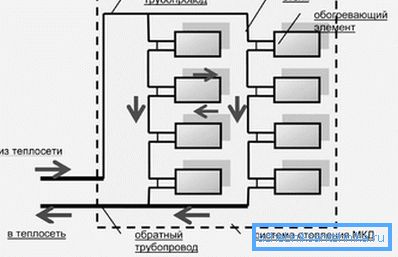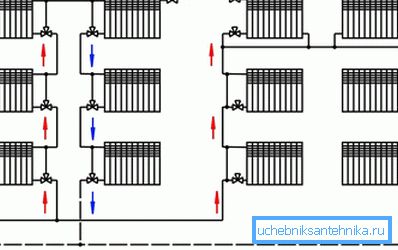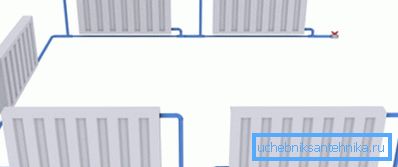Monotube heating system of a private house itself
At a certain period in the history of our country, one of the priority tasks of the state was to provide all citizens with affordable housing. "Khrushchev" began to be erected throughout the USSR. Such apartment buildings had a small area of apartments and were built very quickly. To reduce the cost of construction, invented a variety of new schemes and accessories. The same is true of heating. To reduce pipe consumption, a single pipe system was invented. Since then, this simple but quite effective construction has become widely used in private housing construction. In this article, we will describe how to install a one-pipe heating system of a private house with your own hands.
Pros and cons of the system

Single pipe heating system has its positive and negative sides. Knowing these features, you can accurately answer which one-pipe or two-pipe system is better. So let's start with the pros:
- The most important advantage is saving. With a single pipe system, there is no need for jumpers for batteries, reverse risers and other elements. This results in a nearly twofold reduction in pipe costs compared to a two-pipe heating system.
- It is possible to regulate the flow of coolant to each heating device without a significant impact on the operation of the entire system. This is achieved by installing modern devices such as balancers, ball valves and bypasses, thermostatic valves, etc.
- Another advantage can be considered the aesthetics of the whole system. Since the number of pipes here is small, it is convenient to hide them behind false walls or panels.

All this makes the single pipe system popular. But it is also worth remembering that the scheme of all communications will be quite simple. This makes it possible to carry out the installation of heating on their own without much effort.
But even here it was not without drawbacks and there are quite a lot of them. Disadvantages of the system:
- In order for all heaters to work efficiently, it is necessary to provide sufficient pressure in the system. This circumstance leads to the need to install more powerful pumps, which leads to an increase in operating costs.
- The installation of the circulation pump itself may also be a disadvantage. The two-pipe system does not need such additional equipment, it is mounted only for efficiency.
- When developing a scheme of a single-pipe heating system, it is necessary to provide for the location of the pipes so that the coolant will drift. In practice, this feature involves installing an expansion tank at the highest point of the system. As a rule, this additional detail is mounted in the attic.
But, despite these drawbacks, cheapness prevails, and single-pipe heating systems are most often found in private homes, especially with a small living space.
Varieties of monotube systems
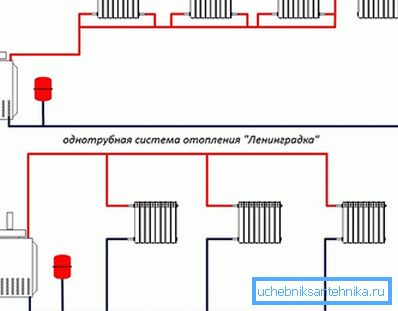
Despite its simplicity, a single-pipe heating system has variations. In private homes, you can use two types:
- Consistent or unregulated system. In this case, the coolant enters each device in turn, the output is water with a lower temperature, which enters the next radiator.
- The regulated system, the people called it "Leningrad". This option allows you to adjust the flow of coolant in each radiator. Devices are connected to the highway in parallel.
The first option is considered the easiest and cheapest in execution. But it does not allow to regulate the flow of coolant, so the batteries that are located farther from the boiler, will have a lower temperature. For this reason, a consistent one-pipe system is used only for heating small houses or individual rooms.

The "Leningrad" system in terms of regulation and uniform heating of all devices is better. Here there is an opportunity to regulate the flow of coolant to each device with the help of valves. Such systems can be installed in homes with a large area.
In addition to the above principle, one-pipe systems are divided by the method of circulation of the coolant. Here there are three types:
- With natural circulation. In this case, the coolant moves from one radiator to another under the influence of gravity.
- With forced circulation. Such systems are considered more efficient than the first option. For forced circulation of the coolant uses a special pump.
- Combined option. Installation is carried out according to the scheme of a system with natural circulation, and to increase the efficiency a circulation pump is installed in it (via a bypass).
The first of these types of system works effectively only with a small length of the track, for this reason it is used only in homes with a small heated area. To improve circulation, it is advisable to install an acceleration manifold immediately after the boiler. This design involves raising the supply pipe to a meter or one and a half above the level of the first radiator. Installation of an open expansion tank located at the highest point of the system should also be provided.
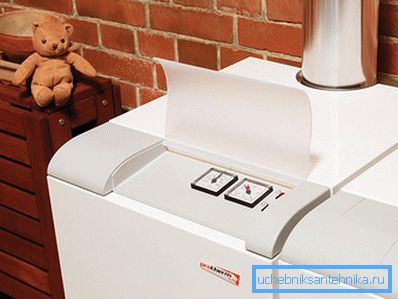
Despite its lower efficiency, the system with the natural circulation of the coolant is quite popular. This is due to non-volatility. If the house has an electronic floor-mounted boiler, then a power outage will not affect the operation of the heating system.
Tip! A more efficient, but at the same time, a design with forced circulation of the coolant is considered to be dependent on electricity. Such systems may have a long contour and not one. In the latter case, several circulation pumps are installed, separate for each circuit.
If there are frequent power outages in your area, and an electronic dependent floor boiler is installed, then it is advisable to install a combined one-pipe system. In this case, in the absence of electricity, your home will not freeze.
System installation
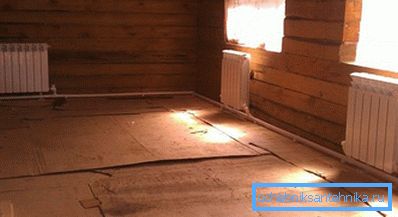
If you decide to make in your home a one-pipe heating system from scratch, then the primary task will be to draw up a scheme. It is necessary to clearly determine the installation location of the boiler, expansion tank, circulation pump, radiators and other devices and devices.
The sequence of installation of a single-pipe heating system will be as follows:
- First, the boiler is mounted. It is better to install it at the bottom of the building, but not in the basement. Do not forget about fire safety measures (around the device, walls, floors and the ceiling are trimmed with non-combustible material). Together with the boiler equip the chimney.
- Next, we install a branch pipe from the boiler. It is better to use pipes with a diameter of at least 25 mm. A highway is pre-laid throughout the house, and heating radiators, valves and other devices are installed. When installing do not forget about the necessary slope of pipes. The heat carrier should move by gravity from the boiler, go through all the batteries and return to the boiler again. This is very important if your system with natural circulation or combined type. In the presence of the pump bias can not be observed.
- When connecting the main pipe to the boiler, it is necessary to install an expansion tank, the type of which depends on the selected heating system.
- It is advisable to install filters on the return line before entering the boiler. This is necessary to protect all equipment from debris and impurities.
If you are installing a system of the combined type or with forced circulation of the coolant, then the pump must be installed using a bypass. In the first variant such combination is obligatory, and in the second one is desirable. Installing the pump through the bypass will provide an opportunity to turn it off in case of repair or lack of power, while the heating system will continue to work.
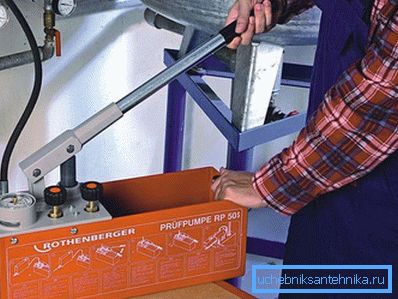
Before starting operation, you must perform pressure testing. This process is done with a special pump that raises the pressure in the system. If in the process of pressure testing the pressure in the system is maintained, then there is no leakage and you can start the heating season.
Video
Watch a video about the installation and installation of a one-pipe heating system in a private house:
Scheme

